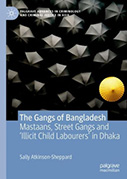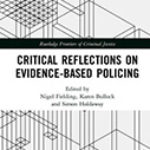The Gangs Of Bangladesh: Mastaans, Street Gangs And ‘Illicit Child Labourers’ In Dhaka

Author: Sally Atkinson-Sheppard
Publisher: London: Palgrave Macmillan, 2019. 215p.
Reviewer: Arild Engelsen Ruud | February 2021
When I was asked to review The Gangs of Bangladesh: Mastaans, Street Gangs and ‘Illicit Child Labourers’ in Dhaka I immediately accepted thinking here is a study of the criminal underworld of Dhaka that I have so far missed. And to some extent it is a study of the criminal underworld of Dhaka and how it works, topics close to my heart and that I have studied and written on as an anthropologist; but it is also a work of criminology – a discipline of which I will not feign any knowledge. So I introduce this review with a disclaimer: I have limited understanding of the discipline the study talks to and will review the volume as an area studies specialist and as someone familiar with the ethnographic field.
The study is about street children in Dhaka, the capital of Bangladesh, and their engagement in acts of crime. The author’s core question is what can we learn from an in-depth study of these children about childrens’ agency and about how we as societies can deal with kids that are both angels and devils?
The volume is a revised PhD dissertation — a study seemingly accidentally conceived as the author joins her husband on a mission to Bangladesh. The author expressed horror toward and no prior knowledge of the country as the volume opens, her Bangla language remains rudimentary, and there are several passages that make a South Asia studies scholar shudder (such as when clientilism, dacoity and thuggery are mentioned in a volume on crime, but left uncommented upon and for the uninitiated reader to join the dots).
Chapters 5, 6 and 7 detail the information Atkinson-Sheppard obtained from the children and other interviewees. These are children who have been engaged in crime and acts of violence, including theft, murder, extortion, fighting and the sale or transport of drugs. There is much to commend these chapters, and much interesting and cruel insight. It is pointed out to her that younger children are more nimble, but they also cry a lot more than older kids if they are caught. They seem to talk openly about forms of crime, how they are dragged into it, and the techniques they have learned. Her material is interesting for it details ethnographic insights for groups otherwise missed in much of the literature on vulnerability. Her field material nicely complements David Jackman’s detailed ethnography of day labourers involved in Dhaka gangs – gangs that partly function as porters but also partly as political goons and loosely organised crime gangs.
In Jackman’s ethnography, patronage, work and protection are important motives for the labourers, which is also the point made here. In Chapter 6 Atkinson-Sheppard theorises on the motives children have for joining these gangs, and suggests the concept of ‘protective agency’. The children have agency and do engage in crime, but their agency is shaped by the violent and unpredictable world in which they live. They seek out patrons in order to find protection and support. They are not necessarily orphans, but they live in conditions of extreme vulnerability and are exposed to rival gangs and exploitative adults.
The author’s point is that the children ‘are not simply innocent, helpless victims, nor are they malicious criminals’ (p. 132). They are both, but their choices have been shaped by the violent and unpredictable environment in which they are growing up. This leads her to chapters 7 and 8, in which she theorises on the implications of this insight on criminal justice and for policy and practice. In terms of criminal justice, she asks what role their own agency if their choices are shaped by circumstance. She wants to challenge the ‘devil or angel’ dichotomy, but acknowledges that there are more questions than answers. In Chapter 8, she addresses research, policy and practice issues, arguing with conviction that criminology needs to include the insight into concepts such as social protection, patron-clientilism and child labour from other disciplines, notably development studies (pp. 153-154).
My main challenge with the volume is the image Atkinson-Sheppard presents of the mastaans, as independent groups of criminals offering services to local politicians and businessmen. First, the term itself refers to individuals, not groups. More crucially, criminal groups not part of a political set-up are rare in Bangladesh. Criminal gangs engaged in smuggling, drug trafficking, excavation of sand or any form of extortion operate with explicit or implicit political protection. Her review of mafia literature from other parts of the world (Italy, Brazil, Russia) leads her to an understanding of crime gangs as somehow independent of politics — a parallel operation only occasionally in cahoots. But in South Asia including Bangladesh protection is everything, even for crime lords. Here she might have found useful insights in the Mafia Raj study of crime and politics in South Asia (to which I contributed), in which this point is made, and which could have added interesting new angles to her study.
References:
David Jackman. 2019. Violent intermediaries and political order in Bangladesh. Eur J Dev Res https://doi.org/10.1057/s41287-018-0178-8
Lucia Michelutti, et al. 2018. Mafia Raj: The Rule of Bosses in South Asia. Stanford University Press.
Arild Engelsen Ruud, Professor of South Asia Studies, University of Oslo


